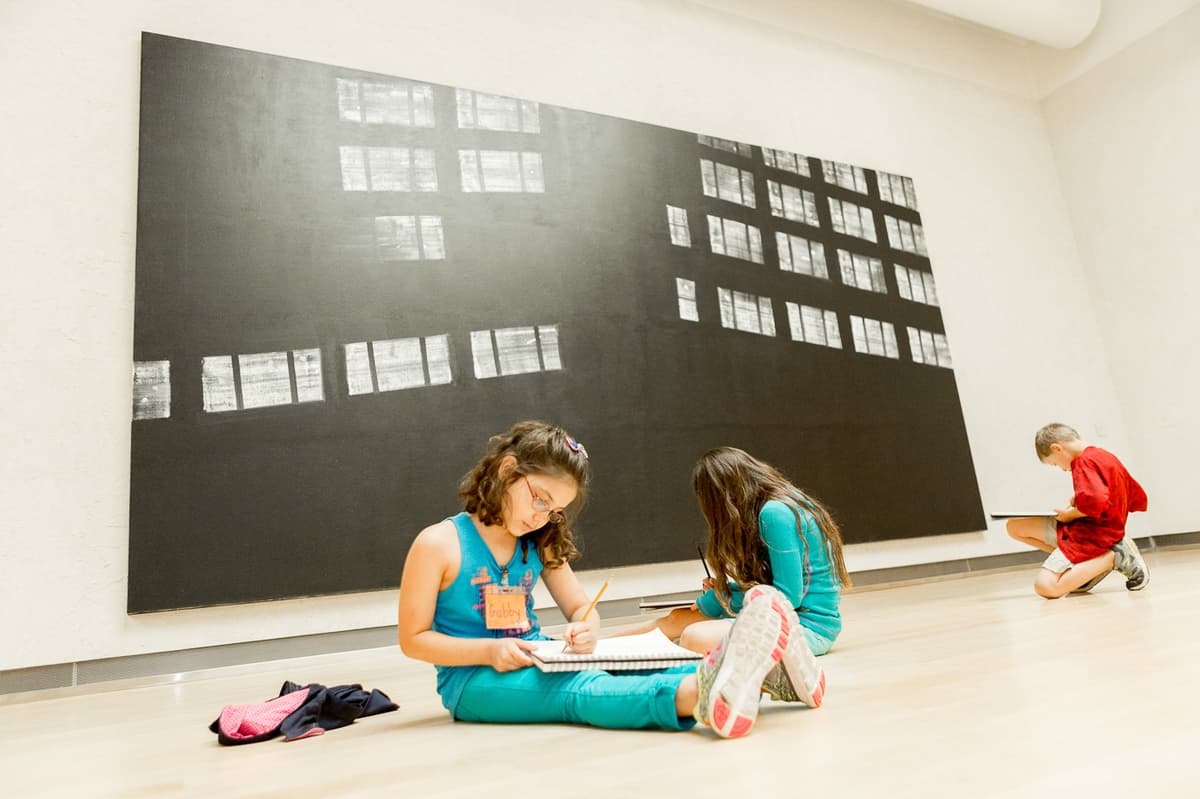Field Trip Experiences
Gallery and Studio Workshop
Field Trip Experiences: Gallery and Studio
Tour: Students discover what an art museum is and how it differs from other buildings. They learn about close looking, make personal observations, and share opinions about works of art.
Studio workshop: Students create their own cat inspired by the works of Gertrude Abercrombie.
Tour: Students see that the elements of a good story are not just confined to the pages of literature—they can also be found in the shapes, lines, colors, and people and objects depicted in works of art.
Studio workshop: Students make choices as artists, creating a small two-dimensional version of themselves inspired by the cutouts of Alex Katz and other portraits viewed in the galleries.
Tour: Students explore how art emerges from its environment, which can refer to physical surroundings, culture, politics, the artist’s inner emotional landscape, and more. Through this framework, students learn about Maine as both a birthplace and a destination for artists, and consider how Maine’s natural beauty and complex history inspired the work those artists created.
Studio workshop: Studio workshop: Students make a pine tree collage inspired by Ashley Bryan’s Tree Gods.
Tour: The lands and waters of Maine have been home to the Wabanaki, “The People of the First Light,” since Creation. Students learn about Wabanaki art, culture, government systems, economics, history, presence, and visions of the future by engaging with artworks made by Wabanaki artists, other Indigenous creators, and non-Native makers. The artworks spark conversations about sovereignty, survivance, cultural revitalization, colonialism, and environmental activism.
Studio workshop: Students practice mark making and storytelling by creating a scratch-basket vessel inspired by Alan Syliboy’s Women on the Island and High Shouldered Tsia Red Clay Storage Vessel.
Tour: Students will make observations, think critically, and discuss how the elements of the art, the curation, and the overall exhibition design work together to communicate lessons about interconnection, survivance, cultural continuity, sovereignty, and ecological knowledge and concerns. The learning experience will be multisensory with soundscapes, audiovisual works, and hands-on materials that stimulate touch and scent. Students will leave the gallery with a strong understanding of Wabanaki cultures, expanding artistic methodologies, and rights to self-determination.
Studio *available only on Mondays with Waterville Create’s Teaching Artist: Students will participate in a brief writing exercise to reflect on a landscape they are personally connected to and want to protect. They will then utilize stamps to build up a pointillist landscape reflecting their journal entry. The Studio workshop is inspired by Melcolm Beaulieu’s The Land that Claims Us, James Francis’ acrylic dot painting, and the Bound Together artists’ collaborative mosaic river.
Joan Dignam Schmaltz Gallery at Paul J. Schupf Art Center, on view from November 19, 2025, to April 25, 2026. *Best suited for grades 5-12. Limit of 25 students per day.
Tour: Students investigate various representations of nature, the environment, and the land to better understand how and why artists interact with and interpret the world around us.
Studio workshop: Inspired by Maya Lin’s Pin River Kissimmee, students use the ideas of the artist, similar materials, and their own personal experiences and knowledge of nature to create a pin art sculpture.
Tour: Students observe how freedom and equality, in all its forms, can be expressed in art. Themes discussed include the Pueblo Revolt of 1680, the American Revolution, the Civil War, the civil rights movement, women’s suffrage, and Wabanaki sovereignty.
Studio workshop: Students identify an injustice and create their own assemblage inspired by John Kessler’s Isolated Masses (For Peace).
Tour: Students investigate artists’ portrayals of themselves, their surroundings, and their cultures. This tour examines themes such as religion, gender, environmental impact, and human perseverance.
Studio workshop: Students use a variety of provided materials to create a collage that represents their sense of self and identity, inspired by Shahzia Sikander’s Uprooted.
Tour: Starting with a reading of Peter H. Reynolds’ book, Ish, students will explore the ways in which art brings families together, establishes tradition and storytelling, and encourages connection.
Studio: Inspired by Ish, where Marisol makes a gallery of her brother’s artwork, families will create their own gallery based on inspiring works in the museum.
Field Trip Experiences FAQ
All field trip experiences are free! The Colby Museum does not charge admission fees, and we provide tours, studio projects (if desired), and lunch at no cost to the school.
Yes, but you must submit a form to be reimbursed. The forms for each academic year are due by the end of June. You will receive further information after your visit is scheduled.
For additional questions, please contact Abigail Newkirk, Linde Family Foundation Senior Coordinator of School and Teacher Programs, at abigail.newkirk@colby.edu.
Up to forty students per visit, and one visit per day.
At least thirty days in advance of your desired date.
We recommend that you arrive ten to fifteen minutes before your tour start time to use the restrooms, store personal belongings, and get settled.
Of course, but please let us know! We can send you guidelines to prepare you and your students for the visit.
Yes!
There is a bus parking spot adjacent to the museum. More information will be sent to the event planner after the visit is scheduled.
Only one school group is scheduled per day, so schedules can be adjusted within reason. Late arrival results in shorter tours and lunch times. If you are running late, please call 207-859-5600 to keep the staff apprised.
Your responsibilities will be specified in a form sent to the event planner after the visit is scheduled.
Yes.
We strive to accommodate all our guests’ needs. Please contact us with specifics prior to your visit so we can make appropriate preparations.
Yes, we have a dining hall where students can eat food we provide buffet style, and also space outside if they bring food from home (no outside food is allowed in the dining hall).
For additional questions, please contact Abigail Newkirk, Linde Family Foundation Senior Coordinator of School and Teacher Programs, at abigail.newkirk@colby.edu.
